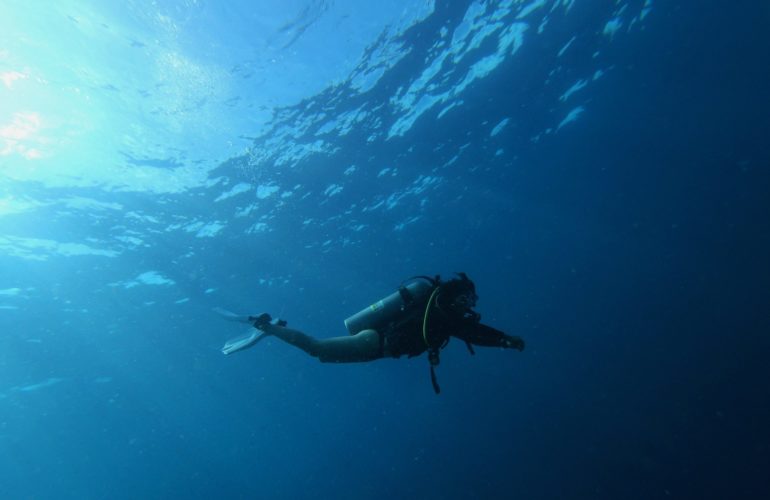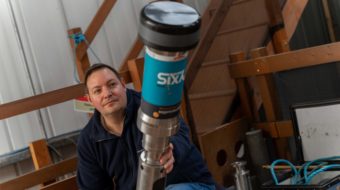Top Tips for Effective Diver Tracking

Divers are used throughout different industries for a variety of tasks; from inspection, maintenance and repair of subsea structures in the offshore energy sector, research and environmental management, to military applications. Knowing the location of people in the water is critical to the safe operation of work being undertaken.
A USBL system designed for shallow-water tracking can accurately determine the position and depth of subsea divers in all environments for reliable and safe systems of work. A USBL system also allows for the marking of targets and waypoints to assist a diver’s navigation in poor visibility.
However, effective diver tracking relies on understanding the intricacies and key features of a USBL system, so you can put it to optimum use. With that in mind, here are some of our top tips.
1. Get your acoustic signal right
Receiving a good acoustic signal is the most important element to achieving a reliable position, and the setup of the vessel transducer is key to this.
The transducer of the USBL system should be at least one metre below the hull of the vessel that it is being installed on to obtain an unobstructed 360° view below the surface of the water. This reduces the impact of acoustic reflections, which can result in inaccuracies of position. Any installation should be as clear as possible from potential sources of acoustic noise such as thrusters and propeller wash.
The tracking transducer should be located as close as possible to the vessel’s centre of gravity, to minimise movement during operations. Vessel transducers can be pole mounted (recommended) or free hung if cabling is suitable.
2. Set your transducer depth
Once installed, the USBL system should have the transducer depth entered, if required, so that accurate Z position (depth of target) can be calculated. Some systems like the Nexus 2 have built-in depth sensors so this is all taken care of. If using a reference position from a GPS or CRP, for example, then the offsets to this point must also be correctly entered. Failure to do this will result in positional errors. However, it is important not to duplicate these offsets in other third-party software.
3. Set the speed of sound through the water (VOS)
A fundamental for all USBL subsea positioning systems is the speed of sound of the water. Depending on a number of variables such as salinity, depth and temperature, the velocity will vary from 1440 to 1520 metres per second. If a velocity profile or measurement is unavailable, applied acoustics systems have calculation tools available.
4. Prepare for shallow water
For the majority of dive operations the diver will be in shallow water, often around structures or sources of reflection. Turning the power down on the transmission and reducing the gain in the tracking system can often reduce the background noise and provide a more stable position, reducing multipath signals.
Some systems will have automatic gain controls and others will be manual. Make sure to consult the operation manual so you’re familiar with these.
5. Select the right beacon and channel
Choosing the correct beacon and channel for operation will allow the operator to track the diver effectively while minimising carry weight for the diver and removing excess noise that can saturate the receivers in the tracking head and cause errors.
For diver tracking, a compact omnidirectional beacon complete with depth sensor is recommended to ensure beam pattern alignment between the beacon and tracking transducer, as well as an accurate depth (Z) measurement. This aids the positional calculation performed by the USBL system. applied acoustics now offers the 1329D with a built-in depth sensor as standard, which improves the accuracy of position and reliability of results.
Each beacon is set to a unique channel to prevent crosstalk and interference with any nearby operations. It is recommended to use a digital encoded channel scheme, for example, applied acoustics Sigma 2, which provides stable positioning and noise immunity. If using legacy CW tone channels, ensure channel separation greater than 500Hz in the uplink and downlink frequency.
6. Beacon location
Remember the acoustic path between the beacon and the tracking transducer is line of sight. Therefore the mounting position on the diver or subsea system has a significant role in system performance.
Our USBL systems at a glance
The Alpha USBL system is designed for quick setup and versatile shallow water use, so is ideal for tracking divers who generally operate within 500m of the vessel. It is a mobile unit designed for quick deployment on small vessels and provides basic tracking and positioning, making it ideal for most small surveying and inspection jobs. It can track up to four targets and doesn’t need a fixed mounting due to internal AHRS sensors.
Our Nexus systems provide a suite of tools for more accurate positioning and surveys. They allow for sigma spread spectrum technology, which offers a secure acoustic link to reduce the system’s susceptibility to interference. This is important when tracking in shallow-water environments where divers are typically utilised.
For optimum shallow water diver tracking, our INS + USBL system Pyxis is the most accurate in the Easytrak USBL range. Combining our bi-directional Sigma 2 spread spectrum acoustic protocol with a factory-fitted inertial navigation system (INS), the system is highly accurate, stable and calibration free, enabling rapid deployment and tracking.
For more information on any of our systems, acoustic beacons or to discuss your application, please feel free to contact the team.



